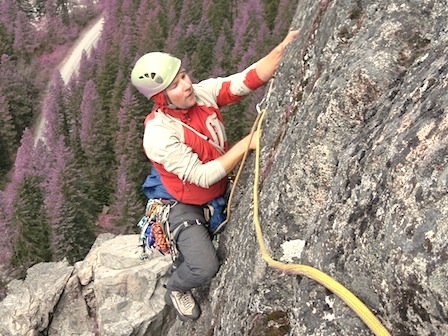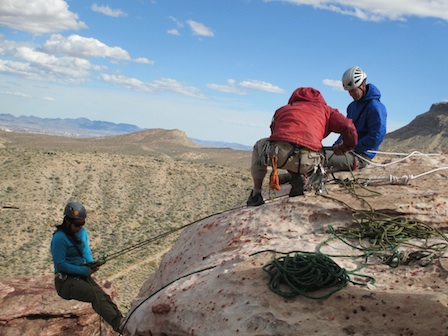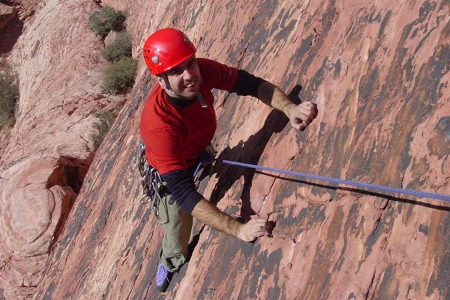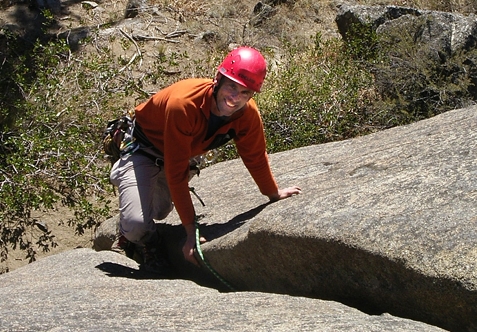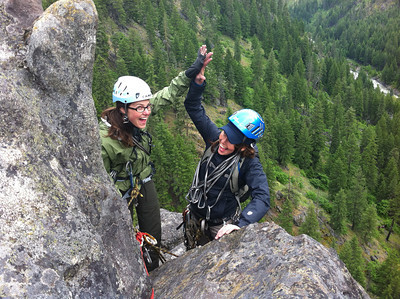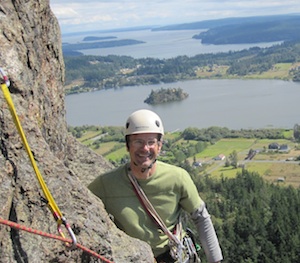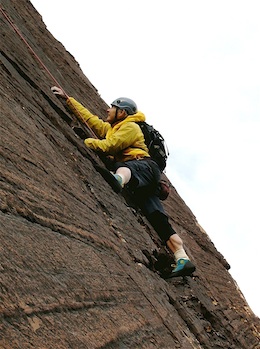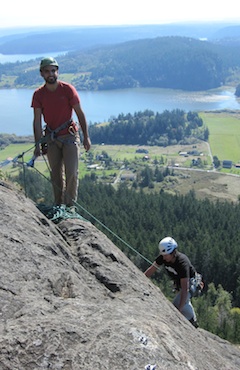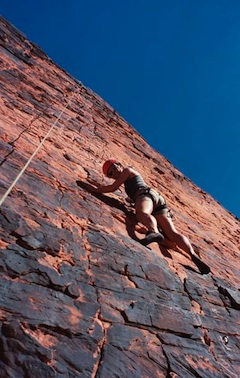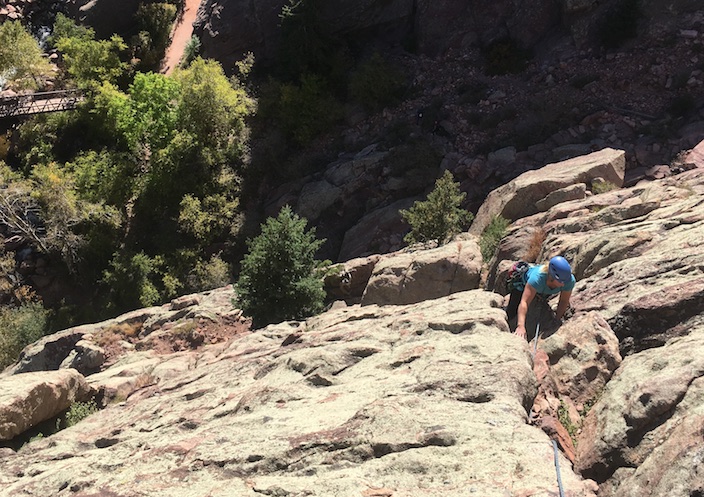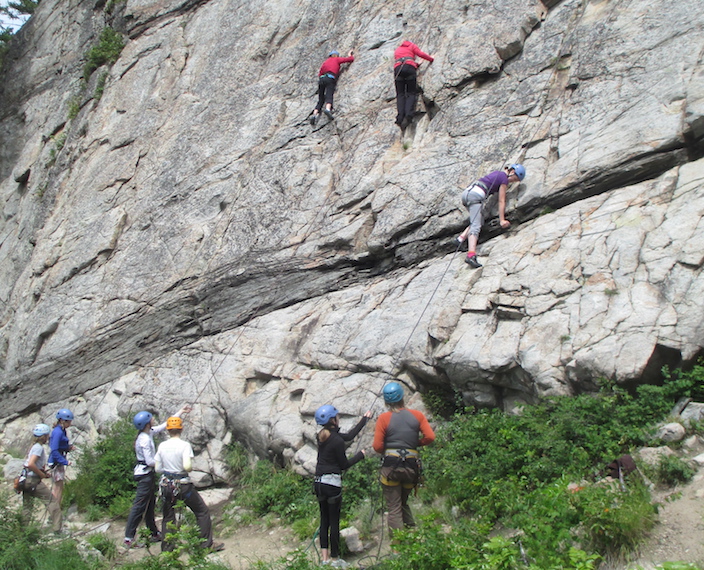Outdoor Rock Climbing - Intensive Introduction Overview A climber demonstrating the use of a hand jam to gain a hold in a crack. Most gyms lack the variety of cracks necessary to learn this technique.
Whether you are new to rock climbing or have climbed indoors previously, outdoor rock climbing presents unique athletic and mental challenges, and demands a wide range of technical and judgment skills that can only be learned outdoors.
This course is designed as a comprehensive introduction to rock climbing, both for beginners who have never climbed before and for indoor climbers who want to transition into outdoor rock climbing or alpinism.
The course has three primary components:
Movement skills , including techniques that are hard to learn indoors, such as jamming and friction climbingTechnical systems , including knots, anchors, belaying, rappelling, and top-rope site managementJudgment skills , including route-finding, recognizing hazards, and risk management
Goals and Objectives
The Outdoor Rock Climbing course was developed to provide you not only with the experience of rock climbing, but with the technical skills required to go climbing without the oversight of an instructor or guide. By the end of the course, you will have the knowledge required to set up and manage your own single-pitch climbing site independently.
VIDEO
Indoor climbing gyms have made it possible for many people to try, and even master, the most iconic type of rock climbing – steep face climbing – without going outside. Outdoor rock climbing, however, demands a much larger repertoire of movement and problem-solving skills than gym climbing.
Outdoor rock climbs don’t announce themselves with colored tape and holds. Learning to route-find often challenges beginners and indoor climbers, who don’t yet know how to recognize usable rock features like underclings, parallel-sided cracks, and small irregularities of the rock surface. Gym climbers who have advanced to the higher number grades can still be stymied by outdoor climbs with features such as jam cracks, chimneys, and friction slabs.
Course Highlights include:
Introduction to Equipment: Design, Care, Use, and Selection
Introduction to Knots and Hitches
Techniques for Belaying and Rappelling
Climbing Commands
Development of Full Repertoire of Free Climbing Technique for Moderate Ground
Introduction to both Passive and Active Traditional Protection
Anchor Construction
Techniques for Setting Up and Managing Top-Rope Sites
Outdoor Rock Climbing - Intensive Introduction Curriculum & Locations Locations
The end of another great climb in Leavenworth. Margaret Utgoff
The Outdoor Rock Climbing Intensive Introduction course is offered throughout the year in some of the most beloved climbing locations in North America.
Winter locations (October - April) include:
Red Rock Canyon, NV - located just minutes outside the city of Las Vegas.
Joshua Tree Nationa Park, CA - approximately an hour away from Palm Springs, CA and right next to the Marine base in Twentynine Palms, CA. The climbing at Joshua Tree is very high quality, and because of its legendary parallel-sided cracks it is ideal for people who want to learn to lead climb on granite walls like those of Yosemite.
Moab, UT - near both Canyonlands National Park and Arches National Park in southeast Utah.
Summer locations (April - September) include:
Leavenworth, WA - about forty minutes from Wenatchee or three hours from Seattle on the east side of Washington's mountains.
Mount Erie, WA - located an hour and a half north of Seattle, near Anacortes, WA.
Squamish, BC - located one hour north of Vancouver, BC.
Boulder, CO - roughly 45 min outside of Denver, CO in the front range mountains.
Mammoth Lakes, CA - located in the eastern Sierra, forty minutes north of Bishop, CA, and three hours south of Reno, NV.
Course Itinerary and Curriculum Day One:
Meet your guide at the program location at 8:00am.
Selection, use and care of climbing gear.
Introduction to basic knots and hitches. Knots to be covered will include but not be limited to the figure-eight follow-through and the clove-hitch.
Introduction to climbing commands and belay technique.
Develop an understanding of climbing grades.
Develop techniques for climbing beginner and intermediate rock climbs.
Day Two:
A beginner climber works on movement skills while on top-rope in Red Rock. Dana Hickenbottom
Review knots from the previous day and then continue the development of your knowledge of knots by learning the figure-eight on-a-bite, the munter-hitch, the overhand, the water-knot, the barrel knot and the autoblock hitch.
Introduction to climbing guidebooks and route topos.
Learn how to place and remove both passive and active rock protection.
Introduction to the concept of SRENE and 12-point anchors.
Develop the skills to build both pre-equalized and self-equalizing anchors.
Learn how to set up simple top-ropes using bolts.
Practice and discuss bouldering technique in an outdoor environment.
Introduction to basic rappelling technique.
Continue the development of movement skills for intermediate rock climbs.
Day Three:
Review knots from the previous days and then continue the development of your knowledge of knots with the double-bowline, the double-fisherman's knot, the mule-hitch, the kliemhiest, and the prussik-hitch.
Learn how to use traditional climbing gear to set up a simple top-rope anchor.
Develop the skills to belay a lead climber.
Learn how to follow a route that has been lead with traditional gear and clean the equipment off the route as you climb.
Develop advanced techniques for rappelling.
Continue the development of movement skills for intermediate rock climbs.
Day Four:
Review all of the knots and hitches from the previous days.
Use traditional climbing gear to set up a complex top-rope anchor.
Learn how to use a static rope or webbing to set up a multipart top-rope anchor.
Practice the rappel techniques that have been developed over the preceding days.
Continue the development of movement skills for intermediate rock climbs.
Outdoor Rock Climbing - Intensive Introduction Dates Mount Erie, WA
May 06 - 09, 2025
June 03 -06, 2025
June 21 - 24, 2025
July 01 - 04, 2025
July 19 - 22, 2025
July 30 - Aug 02, 2025
Aug 09 - 12, 2025
Aug 26 - 29, 2025
Sept 04 - 07, 2025 - LGBTQ+ Only
Sept 27 - 30, 2025
Red Rock Canyon, NV
September 26 - 29, 2025
October 24 - 27, 2025 - Women's Only
November 28 - December 1, 2025
Joshua Tree National Park, CA
Moab, UT
September 31 - October 3, 2025
Outdoor Rock Climbing - Intensive Introduction Details Max Ratio - 4:1 (Climber:Guide)
Capacity - 8
Minimum Enrollment - 3
A note on enrollment: Confirming the 4-day course at the regular cost and length requires at least 3 registrants. With two participants, we can run the course as a 3 day itinerary without changing the pricing; with just one individual we will consider this a 'private course' and charge private rates.
Private Courses:
A private Learn to Lead course can be arranged with the location, length, and dates of your choice. Though the group course is generally preferable for learning, a customized course can be superior for some climbers. The cost for a private course is determined by the private rate for the location.
Prerequisites:
None
Cost Inclusions and Exclusions
Inclusions: Included in the course cost is group technical climbing equipment, climbing permits, and the guide fee.
Exclusions: Not included in the course cost is all personal clothing and climbing gear, gratuities to guide, transportation, lodging/camping fees, meals while on the course, or travel insurance.
Rock Climbing Course Series:
Below is the progression for our rock climbing course series:
Outdoor Rock Climbing Intensive Introduction
Learn to Lead
Technical Self Rescue for Climbers
Multi-Pitch Skills Course
Climbers have a number of potential options for their continuing education, including, but not limited to, the Aid and Big Wall Climbing course and Private Guiding .
Outdoor Rock Climbing - Intensive Introduction Related Courses
Program Finder
By Location
United States - Alaska
United States - Washington
United States - California
United States - Nevada
United States - Colorado
United States - Utah
Canada - British Columbia
South America - Argentina
South America - Bolivia
South America - Ecuador
South America - Patagonia
South America - Peru
Europe - Alps and Caucasus
Asia - Nepal and Tibet
Asia - Laos, Thailand, & Vietnam
Asia - China
Asia - Japan
Africa - Tanzania
Pacific and Antarctica
By Program Type
Instructional Courses
Group Summit Climbs
Expeditions
Skills Expeditions
Private Guided Programs
Treks, Tours, & Backpacking
Corporate Outings & Services
Government & Military
By Activity
Rock Climbing
Ice Climbing
Alpine Climbing
High-Altitude Climbing
Trekking and Backpacking
Skiing & Snowboarding
Guide Training & Rescue
Avalanche Training
Departure Month
July
August
September
October
November
December
Difficulty Level
Beginner
Moderate
Intermediate
Advanced
Very Advanced
x

